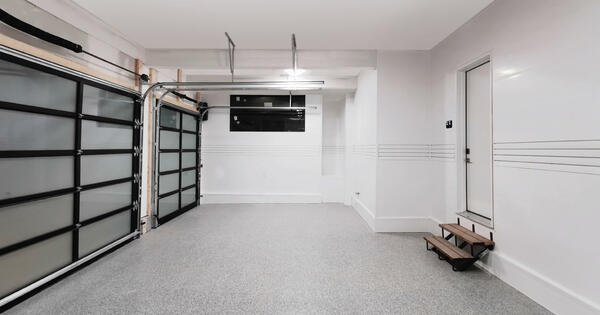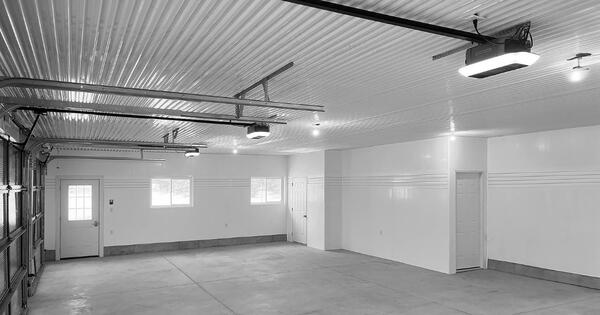This post was originally published in March 2024. Last updated: December 2025.
Maintaining the right humidity in your garage might not be top of mind, but it’s important. High humidity can cause mold growth, rust on tools, warped wood, and unpleasant odors.
In this guide, we’ll explain how to dehumidify a garage, why it matters, and practical ways to control moisture, both with and without a dehumidifier.



What Is Garage Humidity and What Is the Ideal Garage Humidity Level?
Humidity refers to the amount of moisture present in the air. It's a crucial factor in determining the comfort and health of indoor spaces, including your garage. When humidity levels are too high, it can create a damp, muggy environment that's not only uncomfortable but also conducive to the growth of mold, mildew, and other moisture-related issues.
Ideal humidity levels for a garage typically fall between 30% and 50%. This range strikes a balance between preventing excessive moisture buildup and avoiding overly dry conditions.
Now, what happens if humidity levels creep up in your garage? The consequences can lead to costly repairs and more:
- High humidity encourages the growth of mold and mildew which give off musty odors and can damage your belongings stored in the garage, such as clothing, furniture, and even tools.
- Excessive moisture can lead to corrosion of metal surfaces, including tools and machinery, which could potentially shorten their lifespan and compromise their functionality.
- High humidity can also cause wood to swell and warp, affecting any wooden furniture or structures you may have in the garage.
- High humidity can also impact your health by creating a favorable environment for dust mites and other allergens, potentially triggering respiratory issues or allergies.
So, maintaining optimal humidity levels in your garage isn't just about comfort – it's also about protecting your belongings and your health.
What Causes High Humidity in a Garage and How Can You Fix It?
Several factors can contribute to high humidity levels in a garage. Let's break down some common culprits and the solutions to address each of them:
- Poor ventilation: Without good airflow, moisture accumulates. Improve ventilation with vents, exhaust fans, or by opening windows and doors occasionally.
- Lack of insulation: Temperature swings cause condensation. Insulate walls, ceilings, and doors using foam boards, fiberglass, or spray foam to block external moisture.
- Water intrusion: Leaks from rain, snow, or plumbing elevate humidity. Seal gaps, repair roofing, install gutters, and direct water away from the garage.
- Wet items and activities: Damp clothes, shoes, or washing cars inside can add moisture. Dry items before storing, and ensure ventilation after wet activities.
- Weather conditions: Humidity outside affects garage air. Use dehumidifiers during humid seasons, and seal gaps to prevent water entry during rain.
Addressing these factors helps reduce moisture and keeps your garage healthier.
Why Should You Dehumidify a Garage?
Installing a dehumidifier in your garage can help you maintain a comfortable and functional space in several ways:
- Mold and Mildew Prevention: A dehumidifier reduces excess moisture, inhibiting mold and mildew growth. This prevents stains, musty odors, and damage to tools, furniture, and stored items.
- Protection Against Corrosion: Maintaining optimal humidity levels helps prevent metal surfaces, tools, machinery, and vehicles from rusting, extending their lifespan and functionality.
- Improved Air Quality: By controlling moisture, a dehumidifier limits dust mites, allergens, and other airborne particles, creating cleaner, healthier air—especially helpful for those with allergies or respiratory issues.
- Enhanced Comfort: Reducing humidity makes the garage more comfortable for DIY projects, exercise, or other activities, instead of damp and stuffy.
- Preservation of Belongings: A dehumidifier protects moisture-sensitive items like wooden furniture, electronics, and documents from damage, keeping them in good condition longer.
Overall, incorporating a dehumidifier in your garage setup is a practical solution for maintaining a dry, clean, and functional space that you can enjoy and rely on for various purposes.
What Types of Dehumidifiers Work Best to Dehumidify a Garage?
When it comes to choosing a dehumidifier for your garage, several types are suitable, each with its own set of pros and cons. Let's explore the options.
Refrigerant (Compressor) Dehumidifiers
Refrigerant dehumidifiers are the most common type and are well-suited for general-purpose dehumidification, including garage use.
| Pros | Cons |
|---|---|
|
|
Desiccant Dehumidifiers
Desiccant dehumidifiers use a desiccant material to absorb moisture from the air, making them well-suited for colder temperatures and low humidity environments.
| Pros | Cons |
|---|---|
|
|
Hybrid (Combination) Dehumidifiers
Hybrid dehumidifiers combine elements of both refrigerant and desiccant technologies, offering versatility and efficiency.
| Pros | Cons |
|---|---|
|
|
Ultimately, the most suitable type of dehumidifier for your garage will depend on factors such as the size of the space, prevailing humidity levels, temperature conditions, and budget considerations.
How Do You Choose the Right Dehumidifier for Your Garage?
Selecting the right dehumidifier for your garage involves considering factors such as the square footage of the space and the prevailing humidity levels. Here's a step-by-step guide to help you choose the appropriate dehumidifier size and type:
- Measure Your Garage: Start by measuring the square footage of your garage to know its size. Multiply the length by the width. For example, a garage that is 20 feet long and 15 feet wide has a total of 300 square feet.
- Check Humidity Levels: Determine how humid your garage is using a hygrometer, which measures relative humidity (RH). Ideal humidity levels are between 30% and 50%. For instance, if your garage consistently measures 60% RH, you will need a more powerful dehumidifier.
- Determine Dehumidifier Size: Use your garage’s square footage and humidity level to select the right dehumidifier capacity. A common guideline is about 30 to 40 pints per 1,000 square feet. For example, a 300 square-foot garage with moderate humidity may require a dehumidifier that removes 10 to 12 pints of moisture per day.
- Consider Extra Features: Look for features that improve convenience and performance, such as adjustable humidity settings, automatic shut-off, continuous drainage, and programmable timers. For example, a dehumidifier with a timer can run only when needed, saving energy.
- Choose the Right Type: Pick the dehumidifier type that suits your garage’s conditions. Consider refrigerant, desiccant, or hybrid models based on temperature, energy efficiency, noise, and maintenance. For example, a refrigerant unit works well in a standard garage, while a desiccant unit is better for colder spaces.
Considering your garage's square footage, humidity levels, and specific needs can help you select the right dehumidifier to effectively control moisture and create a more comfortable and functional garage environment.
Where Should You Place a Garage Dehumidifier for Best Results?
Proper installation and placement of your dehumidifier are crucial for optimal performance and efficiency. Here are some special considerations to keep in mind:
- Level Surface: Place the dehumidifier on a flat, stable surface to ensure proper operation and prevent any potential damage.
- Air Circulation: Ensure adequate airflow around the dehumidifier by keeping at least 6 to 12 inches of space on all sides.
- Distance from Walls and Obstacles: Avoid placing the dehumidifier directly against walls or large obstacles, as this can restrict airflow and hinder performance.
- Drainage Accessibility: If your dehumidifier has a built-in drainage feature or a condensate pump for continuous drainage, ensure that it is positioned near a suitable drainage outlet, such as a floor drain or sink.
- Power Outlet Accessibility: Position the dehumidifier near a power outlet to ensure easy access for plugging in the unit. Avoid using extension cords if possible.
- Temperature Considerations: Check the manufacturer's recommendations regarding temperature requirements for the dehumidifier.
- Noise Level: Consider the noise level of the dehumidifier and its placement in relation to living areas or workspaces.
- Safety Precautions: Ensure that the dehumidifier is placed away from any flammable materials or sources of heat to reduce the risk of fire hazards.
By taking these special installation and placement considerations into account, you can maximize the effectiveness and efficiency of your dehumidifier, creating a more comfortable and conducive environment in your garage.



How Can I Reduce Garage Humidity Without a Dehumidifier?
While installing a dehumidifier is a key step in controlling garage moisture, several additional measures can further reduce humidity and prevent related problems:
- Improve Ventilation: Increase airflow by adding vents, exhaust fans, or openable windows to remove stagnant air and moisture.
- Seal Gaps and Cracks: Inspect walls, doors, windows, and the foundation for openings, and seal them with caulk or weatherstripping to block water and air leaks.
- Use Moisture Absorbers: Place silica gel packets, activated charcoal, or desiccant bags in closets, cabinets, or bins to reduce humidity in small enclosed spaces.
- Store Items Properly: Keep moisture-sensitive items in sealed containers or plastic bins, and elevate them on shelves or pallets to avoid water damage.
- Keep the Garage Clean and Organized: Regularly sweep, vacuum, and wipe surfaces, and promptly remove standing water or spills to limit dust, debris, and mold growth.
- Monitor Humidity Levels: Use a hygrometer to track humidity and adjust your dehumidifier as needed.
- Inspect Roof and Gutters: Ensure the roof is leak-free and clean gutters regularly to direct water away from the garage.
- Control Outdoor Moisture: Redirect water runoff from sprinklers or nearby structures using gutters, downspout extensions, or landscaping.
- Address Plumbing Issues: Check pipes, faucets, and water heaters for leaks and repair them promptly to prevent excess moisture.
By combining these measures with a dehumidifier, you can effectively manage humidity, protect your belongings, and maintain a dry, comfortable garage.
Should You Install Trusscore in a High-Humidity Garage?
With Trusscore Wall&CeilingBoard and Trusscore SlatWall installed in your garage, you won't have to worry about humidity wreaking havoc on your walls in the same way you do with drywall and medium-density fiberboard (MDF) pegboard or MDF slatwall systems.
Trusscore products are 100% water resistant, will never grow mold and mildew, and will never warp or swell. Plus, they install with a watertight seal to protect insulation and framing from any moisture in the air. It’s a long-lasting wall, ceiling, and slatwall panel system that’s perfectly suited for high humidity and high traffic spaces like garages.
Check out the Trusscore Cost & Materials Estimator to explore design options and see how much it will cost to install Trusscore in your space.


FAQs
Should I put a dehumidifier in my garage?
Yes, if your garage is prone to high humidity, moisture buildup, or mold growth, a dehumidifier can help protect stored items, prevent odors, and maintain a more comfortable environment.
Can you dehumidify a garage?
Yes, you can dehumidify a garage using the right type and size of dehumidifier, combined with proper ventilation and moisture control measures to keep humidity levels within the recommended 30 to 50% range.
Does a garage need a dehumidifier?
It depends on your garage conditions. If your garage is cool, damp, or prone to leaks, condensation, or mold, a dehumidifier is highly recommended to prevent damage to belongings and the structure.
Dehumidifying your garage is essential for maintaining a healthy and functional space. By understanding the causes of high humidity and implementing effective solutions like dehumidifiers and supplementary measures, you can protect your belongings and enjoy a dry, odor-free garage year-round. Take action today to create a space that's both practical and comfortable for you and your family.

![6 Best Drywall Alternatives for Garage Walls [2026 Cost & Install Guide]](/content/images/cache/blog/best-alternatives-to-drywall-for-garage-walls-refresh/best-alternatives-to-drywall-for-garage-walls-refresh-social.45933b7d.jpg)




